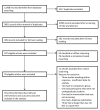Online eLearning for undergraduates in health professions: A systematic review of the impact on knowledge, skills, attitudes and satisfaction
- PMID: 24976965
- PMCID: PMC4073252
- DOI: 10.7189/jogh.04.010406
Online eLearning for undergraduates in health professions: A systematic review of the impact on knowledge, skills, attitudes and satisfaction
Abstract
Background: Health systems worldwide are facing shortages in health professional workforce. Several studies have demonstrated the direct correlation between the availability of health workers, coverage of health services, and population health outcomes. To address this shortage, online eLearning is increasingly being adopted in health professionals' education. To inform policy-making, in online eLearning, we need to determine its effectiveness.
Methods: We performed a systematic review of the effectiveness of online eLearning through a comprehensive search of the major databases for randomised controlled trials that compared online eLearning to traditional learning or alternative learning methods. The search period was from January 2000 to August 2013. We included articles which primarily focused on students' knowledge, skills, satisfaction and attitudes toward eLearning and cost-effectiveness and adverse effects as secondary outcomes. Two reviewers independently extracted data from the included studies. Due to significant heterogeneity among the included studies, we presented our results as a narrative synthesis.
Findings: Fifty-nine studies, including 6750 students enrolled in medicine, dentistry, nursing, physical therapy and pharmacy studies, met the inclusion criteria. Twelve of the 50 studies testing knowledge gains found significantly higher gains in the online eLearning intervention groups compared to traditional learning, whereas 27 did not detect significant differences or found mixed results. Eleven studies did not test for differences. Six studies detected significantly higher skill gains in the online eLearning intervention groups, whilst 3 other studies testing skill gains did not detect differences between groups and 1 study showed mixed results. Twelve studies tested students' attitudes, of which 8 studies showed no differences in attitudes or preferences for online eLearning. Students' satisfaction was measured in 29 studies, 4 studies showed higher satisfaction for online eLearning and 20 studies showed no difference in satisfaction between online eLearning and traditional learning. Risk of bias was high for several of the included studies.
Conclusion: The current evidence base suggests that online eLearning is equivalent, possibly superior to traditional learning. These findings present a potential incentive for policy makers to cautiously encourage its adoption, while respecting the heterogeneity among the studies.
Figures




References
-
- World Health Organization. Global health workforce shortage to reach 12.9 million in coming decades. 2013. Available from: http://www.who.int/mediacentre/news/releases/2013/health–workforce–short... Accessed: 29 May 2014.
-
- Sangrŕ A, Vlachopoulos D, Cabrera N. Building an inclusive definition of e–learning: an approach to the conceptual framework. Int Rev Res Open Distance Learn. 2012;13:145–59.
Grants and funding
LinkOut - more resources
Full Text Sources
Other Literature Sources
Medical
Miscellaneous
